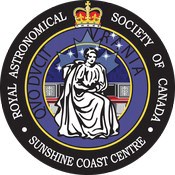This year marks the 150th anniversary of the Royal Astronomical Society of Canada (RASC), the 30th anniversary of the Sunshine Coast Astronomy Club on the Sunshine Coast, and the 10th anniversary of the Sunshine Coast Centre.
Neil Sandy and Merle Gerbrandt put out a newspaper notice in September 1988, and 28 people showed up at a local hall and soon were holding monthly meetings. Gerbrandt was a past president of the Fraser Valley Astronomical Society, and both were directors of the Mt. Kobau Star Party Society. The original Sunshine Coast Astronomy Club was an informal association, never incorporated as a society or registered as a charity.
By November 1988 club members were holding regular meetings, making telescopes, writing regular astronomy articles for the local paper, holding many public star parties, and talking about building an observatory on the Sunshine Coast within five years. Gerbrandt described the club as being “for anyone on the Sunshine Coast, of any age and ladies are welcome.” The club has proudly upheld diversity ever since, with the current membership being 25 per cent female, and the first female president in 2009.
In the mid-90s the club started serious light abatement work, meeting with the District of Sechelt to establish a bylaw for developers to install full cut-off lighting in new areas of the district. Thus began a long tradition of advocacy for light abatement. In 2015 the Centre did presentations to local clubs and community organizations, with the hopes of making a presentation to the District of Sechelt to have them register themselves as a Dark Sky Community under the International Dark Sky Association (IDA) and change their building bylaws to require full cut-off lighting. In December 2017 the club got a member on the advisory committee on the District of Sechelt’s Integrated Community Service Plan and got a motion passed unanimously by the Advisory Council to make Sechelt an IDA Dark Sky Community.
Club activities slowed down in the late 1990s, but all the founding members of the current club came together again in 2004 when Bill Clark saw astronomical articles in the newspaper written by retired UBC physicist Dr. Garth Jones. Clark wrote to Jones to ask him questions about astronomy. Instead of writing a reply, Jones showed up at Clark’s front door. The two decided to put a notice in the paper to see how much interest there might be. Soon the club was holding monthly meetings again at a local school with observing sessions going on in the school field following the meeting.
The club still intended to build that observatory, and various sites were examined from 2005 onwards. In 2009 club members scouted the Sunshine Coast taking calibrated Sky Quality Meters (SQM) and location readings as part of the RASC International Year of Astronomy SQM dark sky program, but also to find an appropriate site for the observatory.
On Dec. 11, 2007, the Sunshine Coast Astronomy Club became registered with the Canada Revenue Agency (CRA) as a charity, with observatory fundraising in mind. At the monthly meeting on April 25, 2008, roughly four years after Bill Clark organized the new club and 20 years after the founding of the original club, the Sunshine Coast Astronomy Club became the 29th Centre of the Royal Astronomical Society of Canada.
The club’s popular Astro Café event, involving a coffee discussion with the astronomers at a local shop followed by public viewing of the skies on the seawall in Davis Bay, started on Feb. 26, 2010, and has been a tradition on the Sunshine Coast ever since. The club has done star parties for community groups and schools and has set up booths and telescopes at community events all across the Coast and held Astronomy in the Park at Porpoise Bay Provincial park for over a decade. This year’s Astronomy in the Park is Aug. 11.
In 2011 the District of Sechelt granted permission to use the Sechelt Airport site for an observatory. A bequest from a member shifted plans into high gear. A gaming grant was obtained in 2013 and the club broke ground on June 3 that year. The observatory had its first light on June 27, 2015 with a grand opening ceremony attended by 450 visitors and many dignitaries. In February 2016 the observatory was nominated for a Wood WORKS! BC award in their Institutional Wood Design - Small Structure category.
In 2014 the Centre entered into a partnership with Eastlink Coast Cable to produce the half-hour astronomy show Night Lights. Production is about to start on the fourth season this year. The club assisted the Aboriginal People’s Television Network (APTN) in 2016 to film the astronomy episodes of their Coyote Science show. And in 2016 the Centre produced a 15-minute documentary for the Bravo channel, Starry Nights, which was released on YouTube in February 2017.
The Centre is now offering the Explore the Universe Observing Program to the public for free. This is open to both the public and members and can be accomplished using nothing more complicated than binoculars. On completion you earn a certificate and observers pin. Contact the Centre at [email protected] or see the national RASC site for details: www.rasc.ca/explore-universe.
– Submitted by Charles Ennis



